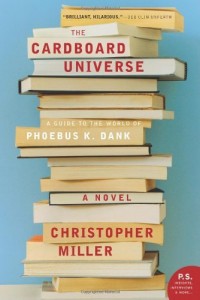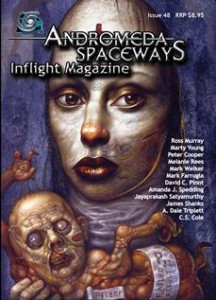written by Frank Dutkiewicz
Daily Science Fiction is the ambitious project of Clarion alumni and Writers of the Future author, Jonathan Laden, and King Arthur fanatic, Michele Barasso. The duo jumped feet first into the growing SF & F industry with an idea that is innovative and ideal with the ever-changing information age. The pair have dedicated getting the best of what today’s writers have to offer, and bringing it right into the laps of the most devote readers of speculative fiction, delivering it as easy (daily email) and as cheap (free) as a lover of fantasy and science fiction could hope for. To insure they’ll have only the best for the cliental, they have offered an attractive pay rate (8 cents a word) to entice the best authors out there.
Why have they embarked on this crazy idea, you may ask?
“Our kids refuse to let us read them Harry Potter, so we needed another outlet for our love of SF” is the answer they offer. Whether their real reason is noble or they really are greedy to read new and fresh fiction before anyone else has a chance to view it, publishing good speculative fiction requires more than a nice pay rate as bait. They need to be able to pick out gems that will make readers want to come back for more. Do Jon and Michele have the ability make DSF a success? I read the first month to find out for myself.
The Stories
“An Adventure in the Antiquities Trade” (debut 9/1/10) by Jeff Hecht is the perfect themed piece to open a mass email project like Daily Science Fiction. The story involves two collectors, and is set in the mid to late 21st century. The protagonist presents a correspondence to a Mr. James, one written on an old manual typewriter in the mid 20th century, when such things were still done on paper. The correspondence tells the tale of a clerk in Nigeria that has uncovered a scheme by the trading company he is working for. The company is bilking the Nigerian government and hiding the profits in a Swiss bank account. The clerk has asked a random American for his bank account so he can transfer 43 million, and promises a 10% kick back as a reward (sound familiar?).
I found “An Adventure in the Antiquities Trade” to be a clever and crisp story. Although it was a bit short, and the twist ending predictable, it was fitting as a debut story for a science fiction magazine looking for a unique way to stand out.
“Mark and ,S-h-e-l-l-y-‘-s-“ (debut 9/2/10) by Steven R Stewart is a story of a pizza shop owner named Mark and his one time romantic interest and former partner, Shelly. Shelly suddenly appears at the spaceport stand, not looking a day older, after a ten-year absence. The sign out front is still the same but her name has been crossed out. The bitter Mark feels cheated, abandoned, and is not interested in any excuse his former partner has to offer. Shelly regrets leaving in a huff all those years ago and admits in making a wrong turn, a turn that may have cost her everything but her youth.
“Mark and ,S-h-e-l-l-y-‘-s-” is a science fiction twist on the old ‘bitter lovers reuniting’ premise. The story is Mr. Stewart’s first publication (nice catch). I found the brief tale to be a cute idea but the present tense narration was a big negative for me. It was unnecessary and lent to a disconnection with the characters and plot.
Butterfly gets her first tattoo on her 13th birthday and receives a gift she didn’t ask for in “Butterfly and the Blight at the Heart of the World” (debut 09/03/10) by Lavie Tidhar. The young granddaughter of the Head of the Council can hear the Rogon, long dead aliens cocooned in the trees of the forest. At first, the incomprehensible murmurs are nothing more than idle chit-chat in Butterfly’s ears, than one day their tone changes. Butterfly believes they are calling her, and they need her help.
At over 9000 words, “Butterfly and the Blight at the Heart of the World” is one of the longest stories you’ll find in Daily Science Fiction. I couldn’t help thinking while reading it that it didn’t need to be so. An awful lot was thrown into the story that had little to do with the overall plot. Much was made about Butterfly’s relationships with other characters when they had little to do with the solution to the story. All the extra material slowed the pacing to a crawl. Another problem I had was the age of the cocoons. The aliens were supposed to be dead for a quarter of a million years, wouldn’t they be fossils by now? What I did like was the unexpected reveal of the nature of the voices Butterfly hears. Unfortunately you had to get through two-thirds of the story to get to it.
“Butterfly and the Blight at the Heart of the World” would make a nice sci-fi mystery if it were shorter. The author took great pains to show Butterfly as a normal girl with a unique problem. Lavie Tidhar made the story mundane in the process.
“Fiddle” (debut 09/06/10) by Tim Pratt opens with a small history lesson on the Roman Emperor Nero, told by a mysterious guide. The guide speaks of the legend of Nero playing a fiddle while Rome burned in the first century AD and offers a unique explanation of how it may have come to life.
“Fiddle” is more like a tease than a story. Its short size limits what I can say about it without ruining it for the reader. Hard for me to recommend it. I found it not attractive enough to call it cute, but I did like that last line.
In “Ezra’s Prophecy” (debut 09/07/10) by Debs Walker, Ezra is a hermit living in a cave. She studies the book of God’s Prophesies with only a weekly visit from a young village woman to look forward to. Then one day the Gods grace her with a vision. Ezra is eager to write her own book of prophesy but takes advantage of her brief gift of premonition to see what effect her holy book will have in the future.
I had two different impressions of “Ezra’s Prophecy”. The first two thirds I found slow and I worried that the plot was headed nowhere. The last third, however, was a making of a classic tale. I found it deep,an outstanding concept on religion and of the people who founded it. Ezra is granted a great gift from the God’s and makes a choice that proves to be an even greater one to her people.
The first half of “Ezra’s Prophecy” is dull, but the end made the pay off worth it.
The protagonist in “Hobo Signs” (debut 09/08/10) by Ree Young is an elderly lady who finds a hobo on her porch. The man has alcohol on his breath and a tale of aliens on his mind.
“Hobo Signs” is almost cute. The story is told from an old woman’s perspective and done well, but I wanted to scream ‘get on with it!’ at her at one point. The story doesn’t have much to it, at least not enough to satisfy me.
“Tag, You’re It” by Melissa Mead (debut 09/09/10) is a tale of a lost soul and a devil playing a childhood game with the playing field Earth. The hider hides as an ordinary person (and other things) while the seeking player hunts them down.
If character growth defines what makes a good story for you than “Tag, You’re It” is your kind of piece. The devil learns much about life as he takes on a trio of different personalities in the game. I rather liked the story. I found the ending fitting. A well done work of flash fiction.
“Seek Nothing” (debut 09/10/10) by Cat Rambo is the story of Sean Marksman, a clone psychologist who specializes in scent alterations. Sean is eager to escape his religious, puritan home. The planet he has escaped to is in need of a specialist like him, but his fellow humans are suspicious of his fundamentalist background. Sean has been raised to believe clones are beings without a soul. His fellow workers treat them as if they are machines , machines that can be abused. As time drags on, Sean begins to identify with the clones plight.
“Seek Nothing” is not a story for everyone. The plot drags and the protagonist is a hard one to like. The supporting characters are portrayed as unsympathetic and aloof , or worse – and the clones are nothing more than living mannequins. However, by the end of the story a realization of the depth of this masterpiece fell on me like a ton of bricks.
This story is one of repression. Sean tires of his purist early life and wants to be a normal man, one free of the guilt of sin his father weighed on him. However, young Sean hooks up with people that are anything but normal and as degenerate as could be imagined. He is like an Amish boy whose first experience with the outside world is with exiled men alone in the Arctic. Added to this jaded experience, details of Sean’s own past surfaces as the story progresses. What we witness in this tale is the disassembling of a man to the point where he feels on par with soulless machines. RECOMMENDED.
“Chameleon” (debut 09/13/10) by Colin Harvey is set in an America under attack by a race of aliens called Dragons and their Chinese allies. The Dragons have the ability to mimic humans, and have gotten good enough at it to make them indistinguishable from the person they are imitating. Major Emily Sparrow has been brought into the ruins of the Pentagon to help determine if her husband is really an alien in disguise.
“Chameleon” is an excellent example on how intriguing and thorough a short story can be. Mr. Harvey opened up a big world and introduced wonderful characters in a handful of words. The story was extra special for me because of its ending. I knew there was a twist coming yet was still caught off guard when the reveal hit me; so subtle and unexpected. It was the whipped cream on top of delicious sci-fi work of art. RECOMMENDED.
“On the Sweetness of Children” (debut 09/14/10) by Michelle Muenzler opens when the Green Fairy falls dead in the middle of blessing the infant princess. She drops at the word ‘hunger’ and the princess becomes a glutton as a result. The round royal is sensitive about her weight, and isn’t above devouring her critics, which isn’t good for her public image. But when you have a bottomless pit for a stomach, public image becomes secondary.
“On the Sweetness of Children” is a very cute story. It is a birth of a fairy tale, which I always find neat. Enjoyable but not “finger licking good.”
Dain talks the crew of the ‘Maidens Crescent’ into stopping at every satellite while traveling through the Sol System in “Mercury in Hand” (debut 09/15/10) by Amanda M Hayes. The Zero-rank magician wants a piece of every planet for a wealthy client to take with him.
I would like to delve deeper into the point of the story but it was completely lost on me. The who, what, and why of the tale is a mystery to me. I didn’t get it and still don’t after I read it three times in an attempt to understand it.
In “Azencer” (debut 09/16/10) by Rigel Ailur, two sisters with the gift of telekinesis battle for the right to be queen.
At a hundred words, Azencer is as short as a complete tale can get. The author did well with so few words.
“American Changeling” (debut 09/17/10) by Mary Robinette Kowal takes place in a quiet Oregon town on a planet called Earth. Kim is the daughter of two faerie changelings. She has been raised for the day to open the gate between the Faerie world and Earth. The key to unlock the gate has been hidden in iron (deadly to faeries) and protected by Catholic magic. Kim is the only one that can resist both, but the enemies to the queen are aware of her and are ready for the great event.
“American Changeling” is an adventure story. It is one of the longest stories in DSF but it reads quick. The characters stand out and the action is well done. The story is done quite well but the general plot is very familiar. Nevertheless, the reading experience is very enjoyable but I would expect nothing less from a pro like Ms. Kowal.
“Flint’s Folly” (debut 09/20/10) by J Chant is a story about a Nobel Prize winning scientist’s, Professor Flint, greatest discovery. His most trusted assistant, Mattius, attends the press conference where Antarctica’s most respected scientist unveils his faster-than-light machine. The demonstration is a success, making the already famous scientist a giant on the world stage. As a close associate, Mattius basks in the professor’s glory, but soon discovers it only takes one mistake to erase a legacy.
“Flint’s Folly” is my kind of story. The author introduced a complete world and set of circumstances that I could buy into. The premise of the story is one I could see happening one day, and circumstances of our not-too-distant past have proved this type of mistake has been made before. Mattius is successfully presented as a loyal comrade. He believes in his mentor and is proud of his past accomplishments. You can feel the validation he feels when the rest of the world cheers for the professor’s breakthrough discovery. Telling the story from his viewpoint was genius with the direction the author decided to take. At the risk of revealing too much, I particularly enjoyed Professor Flint’s attempt to salvage pride at the end, emotionally well done.
This story was great. RECOMMENDED.
Young Revka is ten and has yet to discover her talent in “Picture in Sand” (debut 09/21/10) by Susan A Shepherd. Her mother discovered her woodcarving gift right away, while her father had to search through all nine talents before finding his own. It can be a lot of work before your talent is discovered, or if you’re lucky, your talent may discover you.
Ms Shepherd put a lot of thought into creating her magical world in this story. Impressive considering she didit in so few words. Unfortunately I think the story needed more for it to work. This heartwarming piece came off as flat to me.
“The Man who said Good Morning” (debut 09/22/10) by Ralph Gamelli is set in a future where everyone reads minds and talking is considered taboo. That doesn’t stop Louis McKalty. He first works his voice on his wife, chasing her as if he were holding a dead mouse. He then proceeds to greet the world with his rediscovered gift of speech. The world isn’t prepared to listen to his primitive mode of communication, and if he doesn’t listen to reason, society will send his brand of ‘getting to know each other’ the way of the Neanderthal.
“The Man who said Good Morning” is a fun story about a man who is having some innocent fun. Louis is rediscovering himself and that makes others uncomfortable. I liked how Mr. Gamelli decided to introduce a society where only silent, psychic interaction is allowed. Nice story that could have used some expanding.
Annalisa begs her father to take her to an unsavory fair in “The Jug Game” (debut 09/23/10) by Jennifer Moore. While her father disappears in a beer tent, Annalisa is encouraged to play a jug game. The prize is she gets to keep the soul inside if she wins.
“The Jug Game” puzzles me. The stories ending left me unsatisfied and I wondered if I read the complete version.
“The Fosterling” (debut 09/24/10) by Therese Arkenberg starts off in a shack of a house that is the home of the future king, Hepastian IV. It has been seven years the young prince has lived in the slums and it is Jain Harley’s duty to retrieve the boy and take him to New Geneva to reunite him with his father the king. The foster mother is not ready to give up her ‘Jacky’ and the boy isn’t eager to leave the only home he has known. Jain is chosen for this duty because she does it well, even when crushing migraines afflict her without mercy.
“The Fosterling” is a good story that is written very well. Jain Harley is convincing as a duty bound Captain of the Guard who has a job that simply sucks. All the past kings have spent their first seven years living in the slums so they will learn compassion. Jain is mystified on why Jacky doesn’t want to leave the ghetto he was raised in and wonders at one point “Didn’t all kids dream of being princes?” Coupled with the stress of tearing a young child from the only home he knows, a recurring migraine inflicts Jain.
I could find little fault with this piece. Therese Arkenberg is a very skilled writer. The story is solid and quick but is thin with content. Nevertheless I enjoyed reading it very much.
“Long Pig” (debut 09/27/10) by Matthew Johnson, is the name of a new restaurant featuring a popular chef. The menu is unique and the food is delicious thanks to a chef with a unique past and a commitment to put all he has into his creations.
It wasn’t too difficult to figure out what “Long Pig” was all about. Too many clues made it obvious early on. The chef’s willingness to share his past to his customers made him more creepy than interesting to me.
The restaurant’s customers may have found “Long Pig” appetizing but it didn’t satisfy me.
“Sparks” (debut 09/28/10) by Mari Ness is about a man who has replaced his hands with wands. The protagonist is drawn to the mysterious man and the lovely sparks his wands create. She takes great effort to not stare at his wands and wants to learn why he would make such a trade.
“Sparks” is a story of desire. The protagonist clearly has fallen for the stranger. I however was not drawn into his spell and fail to see the appeal he has over her. The appeal didn’t translate to me.
Unlike the protagonist, I failed to fall under “Sparks” ‘spell.
Jack and Sarah share tea in their home, drinking it out of their favorite cup, just as they always did in “Small Differences” (debut 09/29/10) by Tim Patterson. The only problem is this is the first time they met.
“Small Differences” is a story set in a world where alternate universes have intersected. People are switched into a new one that is very similar to the one they originated in. Slight changes make it different. Sarah and Jack shared a life with their alternate selves and their not-quite-the-same past makes their meeting painful and hopeful.
Not a bad story but one that was too brief for me to enjoy. Not that it needs expanding. I think the author got as much as he could from the idea.
George Washington is about to attend his inaugural in “A Little-Known Historical Fact” (debut 09/30/10) by Tim McDaniel. He talks with his aide Billy and tells him what his mother said he could accomplished if he applied himself.
This short story is just plain silly. The premise relies on GW’s mother knowledge of a term that I believe didn’t exist in her era.
Overview
I asked an editor of a leading review outlet on why DSF is ignored. The answer I got back was there was too much to review and the editors must be nuts if they think they can keep up throwing so many stories, at the rate they pay, for essentially free. Maybe Mr. Laden and Ms Barasso have deep pockets, maybe they have a business model other publications should emulate. I don’t know. I do know, word count wise, they publish as much as Analog, F & SF, and Asimov do each month. Sure they’re putting out 20 plus new stories a month, but 80% are under 2000 words and most are flash fiction size; an easy to get through length if you’re looking for a daily outlet. The question is, does the quality match up to what other pro-rated magazines have to offer. The answer is yes.
I found almost all the stories of a high quality. Because they were so high, my standards for recommendation were raised. If Jon and Michele can continue to publish such thoughtful, creative, and outstanding fiction, I see no reason why Daily Science Fiction won’t be the next big thing in publishing today.
My personal favorite of the month was “Chameleon” by Colin Harvey. I just simply loved it.
I recommend that you all sign up to receive a daily hand-delivered story from Daily Science Fiction. You can sign up for them, and read these stories and other ones here.
 Frank is lurking back around in Diabolical Plots again. Other places have throw him out on his ear but Dave is a sucker for people that have worn out their welcome elsewhere. So Dave has Frank review to keep him out of his hair.
Frank is lurking back around in Diabolical Plots again. Other places have throw him out on his ear but Dave is a sucker for people that have worn out their welcome elsewhere. So Dave has Frank review to keep him out of his hair.











